Los Angeles Filmforum at MOCA presents: Different Every Time
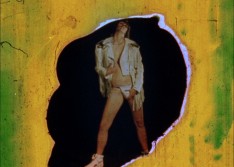
Mariah Garnett, Encounters I May Or May Not Have Had With Peter Berlin
Thursday, May 14, 2015, 7:00 pm
Los Angeles Filmforum at MOCA presents:
Different Every Time
MOCA, 250 South Grand Avenue, Los Angeles, CA 90012
“In every respect,” writes Gilles Deleuze, “repetition is a transgression.” In much of her work, Sturtevant famously repeated the work of other artists in order “to articulate visibilities: to make thought visible.” In connection with the exhibition Sturtevant: Double Trouble, Los Angeles Filmforum at MOCA presents a program of five experimental films related through their use of repetition, but with radically divergent results. Different Every Time features Ken Jacobs’ Soft Rain (1968), Hollis Frampton’s Works and Days (1969), Cauleen Smith’s Chronicles of a Lying Spirit (by Kelly Gabron) (1992), Jill Godmilow’s tribute to the late Harun Farocki, What Farocki Taught (1997), and Mariah Garnett’s Encounters I May Or May Not Have Had With Peter Berlin (2012). Though formally related, each film is aesthetically and politically dissimilar, revealing how varied repetition itself can be. Garnett will be present to discuss her film after the screening.
Tickets: $12 general admission; $7 students with valid ID
Tickets available in advance at http://www.brownpapertickets.com/event/258310
FREE for MOCA and Los Angeles Filmforum members; must present current membership card to claim free tickets
INFO 213/621-1745 or education@moca.org
Mariah Garnett mixes documentary, narrative, and experimental filmmaking practices. Using source material that ranges from found text to iconic gay porn stars, Garnett often inserts herself into the films, creating cinematic allegories that codify and locate identity. Garnett holds an MFA from CalArts in Film/Video and a BA from Brown University in American Civilization. Her work has been screened internationally including the following venues: REDCAT, Los Angeles; White Columns, New York; SF MoMA; Venice Biennial; Rencontres Internationales, Paris, Madrid, Berlin, and Beirut; Midway Contemporary Art, Minneapolis; and the Ann Arbor Film Festival. In 2015, she had a solo show at Louis B. James, New York. In 2014 she was in residence at The Headlands Center for the Arts, Marin; and Made in LA, the Hammer Museum's biennial exhibition. The Los Angeles Times called her piece "Best in Show." In 2012, she took part in a two-person show, Common Era, at ltd los angeles. In 2011, she had a solo show at Human Resources Gallery in Los Angeles titled Encounters I May or May Not Have Had With Peter Berlin.
Programmed by Madison Brookshire
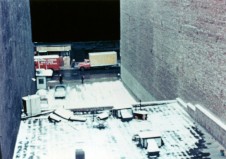
Soft Rain
Soft Rain
by Ken Jacobs
1968; 16mm, color, silent; 12 minutes.
Three identical prints of a single 100 foot fixed-camera take are shown from beginning to end-roll light-flare, with a few feet of blackness preceding/bridging/following the rolls. …The loop repetition (the series hopefully will intrigue you to further run-throughs) automatically imparts a steadily growing rhythmic sense of the street-activities. Anticipation for familiar movement-complexes builds, and as all smaller complexities join up in our knowledge of the whole the purely accidental counter-passings of people and vehicles becomes satisfyingly cogent, seems rhythmically structured and of a piece. Becomes choreography. —KJ
Works and Days
By Hollis Frampton, 1969; 16mm, black and white, silent; 12 minutes.
I bought this film in a Canal Street junk shop for $1.00 and found myself in complete agreement with it. The ostensible pretext is the humane and practical discipline of making a vegetable garden (hence the title, borrowed from Hesiod). The gardeners are masters of their art, so that their work blossoms into overarching metaphor. —HF
By stripping the sound from a pre-existing instructional film, Frampton conjures, with an economy of means, the everyday movements then being explored by the Judson Dance Theater.
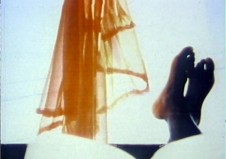
Chronicles of a Lying Spirit (by Kelly Gabron)
Chronicles of a Lying Spirit (by Kelly Gabron)
By Cauleen Smith, 1992; 16mm, color, sound; 13 minutes.
“Chronicles of a Lying Spirit (by Kelly Gabron) is less a depiction of 'reality' than an exploration of the implications of the mediation of Black history by film, television, magazines, and newspapers. Using her alter ego, Kelly Gabron, Smith fabricates a personal history of her emergence as an artist from white-male-dominated American history (and American film history). Smith collages images and bits of text from a scrapbook by 'Kelly Gabron' that had been completed before the film was begun, and provides female narration by 'Kelly Gabron' that, slowly but surely, makes itself felt over the male narration about Kelly Gabron (Chris Brown is the male voice). The film's barrage of image, text and voice is repeated twice, and is followed by a coda. That most viewers see the second presentation of the imagery differently from the original presentation demonstrates one problem with trusting any media representation.” —Scott MacDonald
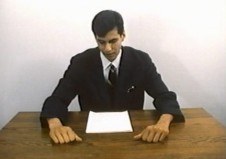
What Farocki Taught
What Farocki Taught
By Jill Godmilow, 1997; 16mm, color, sound; 30 minutes.
with Gloria Jean Masciarotte and Ted Mandell
“To articulate the past historically does not mean to recognize it ‘the way it really was’... It means to seize hold of a memory as it flashes up at a moment of danger.” —Walter Benjamin
“Jill Godmilow remade Harun Farocki's Inextinguishable Fire. She calls it at the beginning of the film ‘an exact replica.’ We know (and she knows) that she is both lying and telling the truth with this statement. It would be easy to list all the ways this film is not an exact replica, beginning with the change of title and rushing toward the nearly five minutes of epilogue at the end. But the ways that it is a replica are more important… In What Farocki Taught, Godmilow seems rather to invoke and resuscitate Farocki's film, allowing it to emerge specter-like at key moments from her film. It creates a curiosity about the original and an interest in seeing it, and thinking about the original context in which it was made. … This is why Godmilow calls her film ‘an exact replica,’ because it is supposed to point back at something, not replace it.” —Tom Gunning
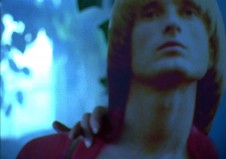
Encounters I May Or May Not Have Had With Peter Berlin
Encounters I May Or May Not Have Had With Peter Berlin
Mariah Garnett, 2012; 16mm, color, sound; 14 minutes.
The film guides the viewer through the process of making contact with a figure who exists only in his own photographs—70’s gay sex icon Peter Berlin. The film is structured in three parts, which were made chronologically. In the first part, the filmmaker appropriates Peter Berlin’s outfits and poses, playfully attempting to embody Peter Berlin’s artistic persona. Each frame of the original 16mm film was then hand-painted to distort the image, producing an animated effect that prevents the viewer from seeing the full performing body. In the second part, a voice over relates a story riddled with anxiety about a potential meeting with Peter Berlin that is paired with images of mansions and window displays. The third and final section is an interview with Peter Berlin in his apartment, describing a moment of exchange that crosses lines of gender and generation, a moment where the identities of two filmmakers briefly coalesce. —MG
